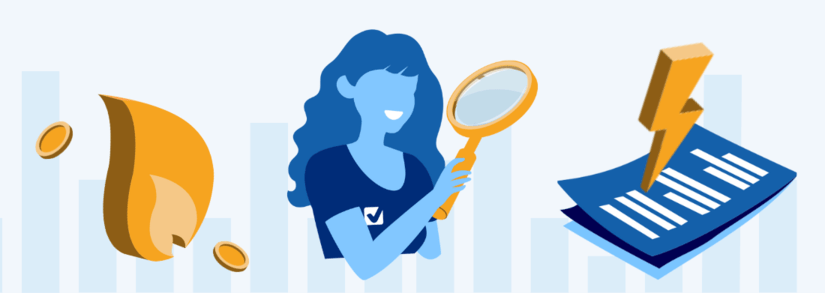How To Read Your Energy Bill - A Helpful Guide

Understanding your energy bill can at times be confusing. Here at Selectra, we decided to break down a typical home energy bill so that you know exactly what your energy provider is charging you for. Understanding terms such as kWh, standing charges and other acronyms such as VAT, MPRN etc will help you feel more confident when reading your next energy bill and could be the key to more savings on your home energy bills.
Key Terms to Understand On Your Energy Bill
Before having a look at what a home energy bill consists of, it’s important to highlight perhaps the three most important terms to know when reading your energy bill.
kWh
Simply put, a kilowatt-hour (kWh) is a unit of measurement used by energy providers when calculating how much energy, either electricity or gas, you have used in a given period of time.
One kilowatt-hour is equivalent to 1,000 watts of energy used for 1 hour. For example, a 2,000-watt electric heater running for half an hour (0.5 hours) will consume 1 kWh.
The average Irish household will use about 14-15 kWh’s of electricity per day and about 10-12 kWh’s of gas per day. Variables such as the time of year, how energy efficient a home is etc, will play a role in how much energy you use so take this as a broad average.
One kWh will get you about one cycle of a dishwasher or about 30 mins of use from a standard kitchen oven.
Tariff Type
The word tariff is a way of saying 'energy deal' or ' energy package' and its name will be displayed on your bill.
An example of a tariff from Electric Ireland would be Urban 24hr for electricity which means you live in an urban area and are charged the same price per kWh no matter the time of the day it is.
A day/night tariff from Electric Ireland would be for example thier Urban Nightsaver for electicity where you are charged a day rate, and then a lower, night rate per kWh.
There are also rural tariffs which can be more expensive per kWh depending on the supplier.
It’s important to know what tariff you’re on, as if you ever find yourself trying to renegotiate your plan with your energy provider, or are looking to switch provider, you will need to know what tariff you are signed up to.
Our energy supplier comparison guide will help you to switch providers, even if you’re not sure what tariff you are on.
Unit Rate
This is the price you pay per unit of energy, in this case per kWh of energy used. In simple terms, this is how much your provider charges for 1 kWh of energy.
For example, one kWh of electricity on the Electric Ireland Urban 24hr costs 27.23c/kWh, including VAT, meaning for every kWh of energy used in your home, 27.23 cent is added to your bill.
Prices are subject to change so keep an eye on your suppliers website to see if they make any changes to thier prices.
It’s very important to know exactly how much the unit rate for your energy plan is. It’s very possible that you may be able to get a cheaper unit rate by switching to a different tariff or even to a new provider completely.
Knowing these terms and where to find them on your energy bill is key to understanding your energy bills and will help you better manage your home domestic finances.
Before looking at electricity and gas bills in detail, it’s important to stress that this is intended to be a general guide, as bills from different suppliers may not always look the same.
Read Our Guide to Electricity and Gas Terms
Understanding Your Electricity Bills
Now that we know about the most important terms, let's have a look at an electrcity bill in more detail to see what other information it contains.

Customer Information:
This section includes the name of the account holder, the account number, and address of the customer.
This is often found at the top of the bill.
Billing Period:
This shows the start and ends dates of the billing cycle covered by the bill.
In Ireland, this is usually every 2 months, or about every 60 days.
Meter Reading:
Meter readings are used to calculate your electricity bill. Your current and previous meter reading will both be displayed here. You will see one of three letters that indicates the type of reading.
- E - This indicates that your bill is estimated based on the average consumption of the house.
- A - This shows that your bill is from an actual meter reading of your home.
- C - This is to show that the reading comes directly from the customer.
What's the Difference Between an Estimated and Actual Meter Reading?
The Electrcity Supply Board (ESB) try to take an actual meter reading 4 times per year so that your energy provider can give you as accurate a bill as possible.
This estimation may be based on previous readings or the average energy use of a similar home to yours. What this means is that you may be overpaying for your electricity
If estimates are based off readings taking during winter, when we use more electricity, then your summer bills may be higher than they should be.
Similarly, if your bill is an estimate based off of other homes in the area, you may well use less electricity than others and therefore be overcharged by your energy provider.
Sometimes it can be the case that an estimated bill is undercharging you! In this case, you will owe money to your supplier.
Get a Smart Meter
The best way to avoid the problems of estimated and actual meter readings is to replace your standard credit meter with a smart meter.
Smart meters relay your home energy consumption directly to your supplier in real time, ensuring that you are only charged for the energy that you use.
On top of this, you can accurately track your home electricity usage through the digital display on the meter, meaning you’ll be able to compare your own records to your bill to make sure it’s accurate.
Read all about smart meters and the benefits they offer with our dedicated smart meter article.
MPRN
The Meter Point Reference Number (MPRN) is an 11-digit code that you will see displayed on your bill and identifies your home’s connection to the electricity network.
It’s important to know this number as if you ever have problems with your supplier or indeed are looking to switch provider, you’ll need to reference this number so that your home and meter can be located.
Charges Breakdown:
Your bill will include a breakdown of the charges that comprise your bill. This is so that you can know exactly how the total final charge of your bill was calculated. The final charge will consist of:
- Unit Charges - The cost per kWh multiplied by the amount of energy used.
- Standing Charges - Fixed daily or monthly fees for maintaining the connection.
- PSO Levy - Public Service Obligation levy, a government-imposed charge to support renewable energy and other services. This is currently set at 0 until September 2024.
- VAT - Value-added tax applied to the total bill. Currently at 9% until October 2024, it has been lowered from 13.5% to ease the financial pressure of home energy bills
Total Amount Due
Probably the first thing you look at on the bill, the total amount due will be displayed at the bottom when all charges and taxes have been added together.
Payment Methods
Some suppliers will include details of the payment method used for the bill, for example direct debit or bank transfer.
Customer Support Information
Your provider will also include contact information for their customer support lines. This is most commonly a phone number displayed at the top of the bill.
Understanding Your Gas Bill
Gas bills are very similar to electricity bills and will also display the same important information such as:
- Your account number
- Your address
- The billing period (usually 2 months)
- Your meter reading
- Contact information for enquires
- Total Amount
- Payment Methods
- Contact Details
Despite this, your gas bill will also display some additional information that you won’t find on a typical electricity bill.
GPRN
Your Gas Point Reference Number (GPRN) is similar to your Meter Point Reference Number (MPRN) and consists of a 7-digit code that identifies your gas meter.
AC Band
Your annual consumption band is allocated based on your average consumption of gas in a year.
There are 5 letters that represent the estimated band your home falls into:
- A = Less than 6,000 kWh
- B = 6,000 kWh to 23,500 kWh
- C = 23,000 kWh to 73,000 kWh
- Y = 73,000 kWh to 750 MWh
- Z = 750 MWh to 5,500 MWh
Usage Conversion
This will show you how your supplier calculated the amount of gas used in the current billing period.
Your gas consumption is measured in cubic meters (m³) as the difference between your current bill and your previous bill.
This is then converted into kilowatt-hours (kWh) by your supplier, which is then multiplied by the unit rate of your tariff.
Charges Breakdown:
- Unit Charges - The cost per kWh multiplied by the number of units consumed.
- Standing Charges - Fixed daily or monthly fees for connection and maintenance.
- Carbon Tax - An additional charge based on the amount of gas used. As of 2024, the rate is €56 per tonne of carbon dioxide ommited. Based on the average home consumption of 11,000 kWh, this will add about €20 to your bi-monthly gas bill.
- VAT - Value-added tax applied to the final bill.
What If I Can’t Pay My Energy Bills?
Paying for our home’s electricity and gas can at the best of times bring financial pressures to many households, let alone in recent years when unprecedented world events have seen the prices of energy rise significantly.
However, if you find yourself dealing with the cost of living and struggling to manage your energy bills, there are steps you can take to try and manage the situation.
Talk To Your Supplier
While it might feel like surrendering to the enemy, you are a customer of your energy supplier and the last thing they want to do is lose a customer, and receive any negative reviews that may come with it.
If you find you are struggling to pay your bills, contact your energy supplier's customer service centre and explain your situation to them.
The CRU (Commission for Regulation of Utilities is the regulatory body for energy suppliers in Ireland and requires that they:
- Assist customers who are in genuine financial difficulty with their energy bills.
- Have trained staff who can speak to customers about problems they are having keeping up with their energy bills.
- Offer customers an alternative payment method, or spread out their energy costs to ease the financial burden their bills are placing them under.
- Adhere to the Energy Engage Code, whereby suppliers promise to never disconnect a customer, but rather actively work with them to find a practical solution.
Social Welfare Supports
The government through the Department of Social Protection offers a range of supports for those on low income that may be struggling with their home energy bills.
- Household Benefits Package - Only available to those over 70 years of age, this is a non means tested financial support aimed at helping people struggling to pay home energy bills. €35 is paid directly into your bank account once per month.
- Additional Needs Payment - Another means tested financial support for individuals struggling to pay for essential services such as home energy bills. This is a means tested payment and the amount you receive is dependent on factors such as your weekly income.
Switching Suppliers
One of the best ways to ease the pressure of household energy bills is to switch supplier. Many are offering competative rates and you could find a tariff that suits you better than that of your current provider
Not sure if you are getting the best deal on your home electricity and gas? Have a look at our energy supplier page to see if you can find a better deal for your energy needs.
Call Today to Switch Energy Providers and Save On Your Energy Bills
Rated ⭐⭐⭐⭐ on Trustpilot So You Know Selectra Customers Get Energy Advice You Can Trust!
Call Today to Switch Energy Providers and Save On Your Energy Bills
We're currently closed but please leave us your number and we'll give you a free callback as soon as we're open!

